Character is one of gaming’s last great challenges.
This post originally appeared on Kotaku UK.
Initially games required characters to do nothing more than act as a gateway into their virtual world, which they achieved using cheerful cartoons like Mario and Sonic, or heroic archetypes like Lara Croft or the Master Chief. Certain genres, primarily RPGs, naturally went further than this, providing a colourful cast of individuals, each with their own personalities and motivations.
Increasingly however, all games regardless of their genre are expected to do more with character, to provide something in addition to the traditional power fantasies. With mainstream studios, where budgets are high, risk-taking is low and the methods of game development are well established, creating complex and relatable characters is a difficult task. It’s a challenge that involves many different people, some of whom the industry is comfortable working with, and others who it sometimes struggles to fit within its infrastructure.
To illustrate this process, I spoke to artists involved at each phase of a character’s creation about what their role involves, how that influences the other stages of development, and what, if anything, can be done to improve their ability to create compelling characters.
In most circumstances, a game character’s life begins at the concept art stage, which immediately differentiates it from other mediums where characters begin at the script level. It isn’t an instantaneous process, however. Game characters emerge gradually from a game’s more general groundwork.
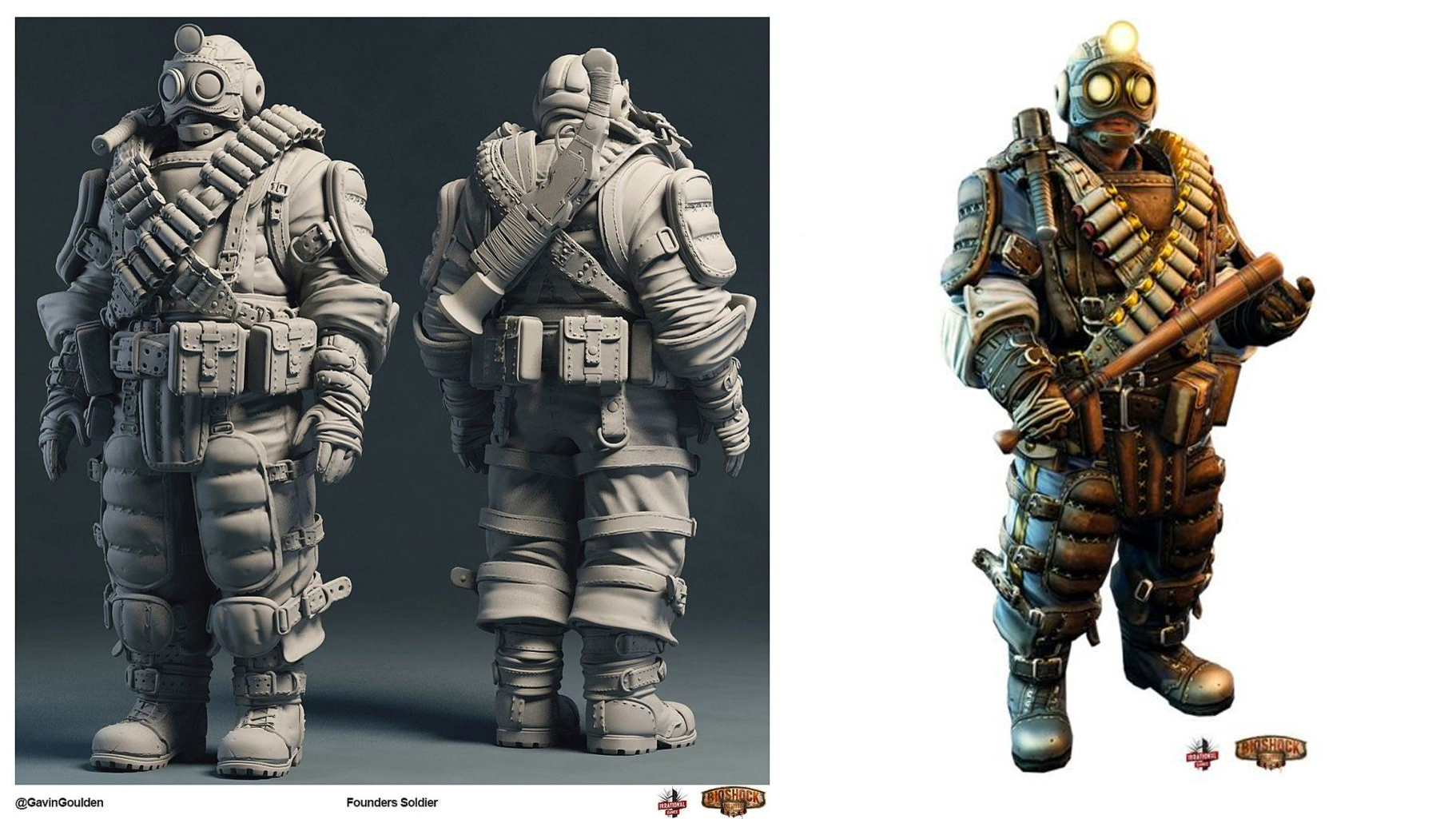
Concept art for Bioshock Infinite by Gavin Goulden
“For the most part a game’s initial direction is driven by the creative director of a project,” says Gavin Goulden, lead character artist at Insomniac games, and formerly lead character artist on Bioshock Infinite. “In tandem, the art director will drive the visual elements of the game and work with other directors to make sure that design ideas are represented in the proper way, visually.”
According to Goulden, specific individuals are born out of the initial world-building, defined in part by aspects like theme, time-period, and genre. This narrows down what characters will likely wear, what equipment they might have available, and to a certain extent how they might act. “From there, you begin breaking down what the game needs and what you can handle on a technical level. The general population, the enemies in the game, key characters, the protagonist,” Goulden adds.
At this point, where the broader concept is broken into strands and the workload shared among the development team, individual characters begin to emerge. Goulden notes that communication becomes extremely important during this stage, both between the different departments in the studio, but also between the artists themselves. “We, as artists, are following a specific direction to stay cohesive and look as if everything is made by one artist.
“But at the same time, art is often what you would consider a service department, for lack of a better term. Oftentimes, we have clients internally that you need to make happy, you don’t just ‘make art’ — you make it for a reason. So generally model requests will come from design. You create those assets in a way that can be animated, and fit within the budget for your area of the game.”
Once work has been allocated, the next task becomes prioritisation, namely; where is the budget going to be spent? In terms of characters, Goulden states that this is primarily determined by screen-time, but can be sub-categorised into main character, supporting character, side-character and so forth. “Most likely, your background character that is only ever a few pixels on screen won’t need as many polygons as the main character who you see 100 per cent of the time.”
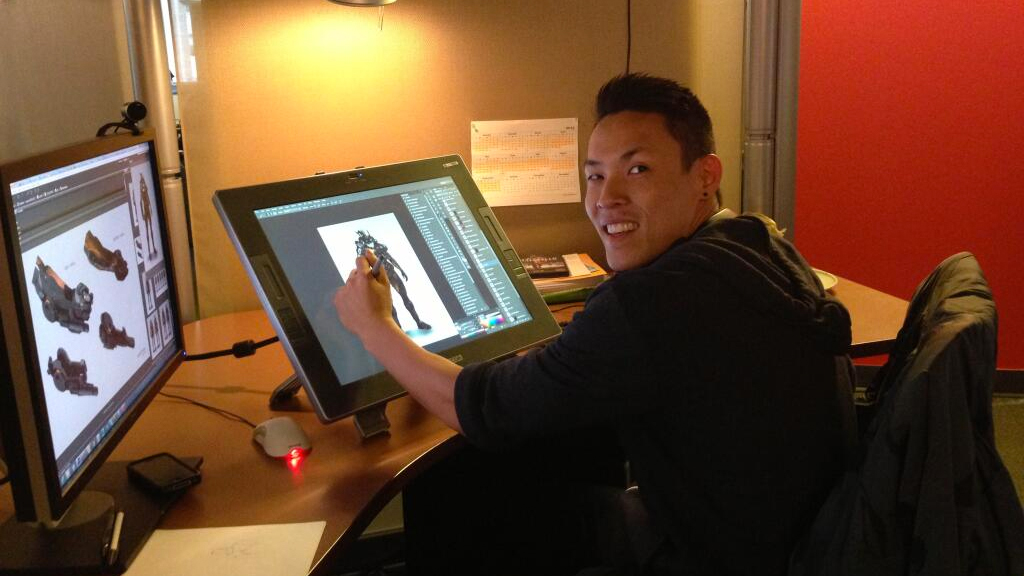
An animator works on artwork for the newest Mass Effect game
With the protagonist, when a basic idea of what he or she will look like has been outlined, the concept artists begin working in collaboration with animators on the full 3D model. Jonathan Cooper, lead animator on Mass Effect 1 and 2 and animation director for Assassin’s Creed III, emphasises the importance of involving animators at the earliest possible opportunity. “Even at this early stage the animators will be involved in discussions that aim to make our jobs easier in the long-term, such as strong silhouettes, opportunities for cloth and physics-driven motion etc, and pointing out potential issues that might arise such as armour that won’t move correctly once in motion.”
It isn’t simply about the practicalities of animation, either. Animation is equally crucial to defining much of a character’s personality through how they walk, personal affectations, gestures, facial expressions and so forth. Starting this process early means these things can be more naturally imbued into the character.
“Ways they stand and carry themselves are the easiest starting points, all with the goal of looking for an iconic image or silhouette that will make them instantly recognisable and distinctive among all the other game characters already out there,” Cooper says. In addition, he points out it’s important to consider the type of game being made. A game like Mass Effect, where the player inhabits and determines the personality of the individual, demands a protagonist whose movements and gestures are less suggestive of their personality than something like Tomb Raider or Uncharted.
In Cooper’s experience, the relationship between animators and concept artists is well-established in mainstream studios and largely works well in terms of developing the visual aspects of characters. That said, he points out a couple of issues. “I feel we often simply include far too many characters, from mission-givers to enemies that die in the thousands, rather than travel with the same cast of deep individuals and watch them progress over the course of the game.” He also adds that, although the visual element of characters is something large studios can do in their sleep, the role of writers is something the industry is far less comfortable with. “Unlike animated features, we rarely start with a script or storyboard of the entire game, and if we do it can evolve radically as we figure out the gameplay and required technologies.”
This is the issue mainstream developers struggle most with when creating compelling characters, because when it comes to the nuance of characterisation, the writer easily plays the most significant role. “The industry is still getting its head around the idea that employing professional writers is a necessity, rather than a luxury,” says Rhianna Pratchett, writer on games including Tomb Raider, Mirror’s Edge and Overlord.
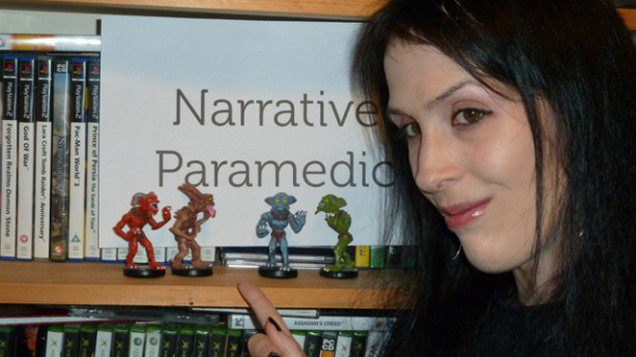
Rhianna Pratchett laments the last-minute ‘Narrative Parademic’ changes she often has to co-ordinate
Pratchett explains that a writer is usually employed to work on a game in one of two ways, either full-time in-house, working alongside the developers, as is the case at studios such as BioWare, or on a freelance basis over the course of a few weeks or months, which is how she normally works. “Sometimes writers are only employed towards the end of a project to polish up script and characters. I call this being a ‘Narrative Paramedic’. It can be a bit soul destroying as you often see so many things you could’ve fixed if you’d been hired earlier on in development.”
In terms of specific characters, the job of a games writer working for or with a major studio is to add depth to that individual which goes beyond merely what they look like. “Usually you’ll write a backstory and bio for that particular character which will then be used to inform animators, actors and the audio department,” Pratchett clarifies. This involves striking a balance between narrative requirements and what the developers want to do with the game, which isn’t always easy. “I’ve quite often had to kill off characters because of budget constraints, or because the gameplay required it.”
Regardless of whether a writer is full-time, part-time, freelance, or a narrative paramedic, Pratchett emphasises that developers can help writers in their job enormously through frequent communication, even if the writer is working remotely. “Wherever possible developers should endeavour to make the writer feel part of the team, and not as if they’re off to one side, just being given instructions. It creates an ‘us and them’ scenario between gameplay and narrative which isn’t good for the end result.”
Once the script is ready to go, the final piece of the puzzle is the actor or actress. You might think actors aren’t a necessity when it comes to game design, and it’s true some games get along well enough with a purely written narrative. But certainly with mainstream studios, rarely will you see a game that doesn’t employ actors in one form or another. Besides a good acting performance can be a huge boon in conveying the emotions or behaviours of a character.
Much like the writer, the role of actors is something the games industry is still grappling with, although of the two it has a more established routine with actors. “Typically we get background, and concept art, and a few line to audition with, and that’s all we get until we show up at the job,” says Jennifer Hale, a veteran games actress whose major roles include Commander Shepard in Mass Effect and Samus Aran in the Metroid Prime series. “It’s what we call “cold reading”. When you go into work it’s all cold reading, you’re going on your instincts, you’re going on the director’s input, if you’re lucky the writer, and often producer are there to guide you.”
Generally speaking the actor is expected to read the lines provided, and is often given only minimal context regarding what the character is like. It’s usually up to the actor to find the character’s motivation, to inject not just authority but emotion into that individual. The extent to which they can be flexible on this depends upon the developer. “BioWare’s stuff, you don’t deviate a letter from what’s on the page. You’re working on something like Bioshock, with Ken Levine and those guys over at Irrational, we had some room to do improvising.”
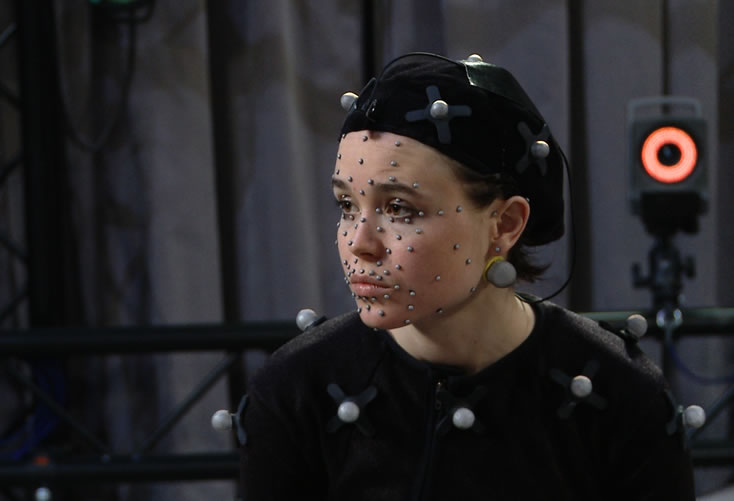
Ellen Page wears motion-tracking studs for her part in Beyond: Two Souls
Traditionally we’d refer to game actors as “voice-actors”, but increasingly this isn’t the case. Many studios employ motion-capture software to capture the full-body performance of the actors, incorporating the mannerisms they provide into the animation of the character. This form of acting is one which Hale particularly enjoys, although she is keen to point out that even if it’s only the actor’s voice that is recorded, is isn’t “voice-acting”:
“In my experience, when someone’s not actually having an experience when they’re acting in something, when they’re just ‘doing a voice’ quote unquote, you’re not going to have an experience when you play. You may have an intellectual appreciation of ‘Hey, that looks funny’ or ‘Hey, that’s cool-sounding’, but you’re not going to be moved at all.”
Hale feels that, like writers, actors in the games industry are somewhat under-appreciated and not always best utilised. However, she is witnessing gradual improvements and new ways of working with actors, which she believes lead to a better result. In Bioshock Infinite and Metal Gear Solid 4, for example, she recorded the lines with her co-actors Oliver Vaquer and David Hayter. “Whenever you get to record with the person you’re actually speaking with, it raises the level. I’m seeing more of that happening very gradually, but I’m seeing little bits of it. I’m seeing the levels of collaboration and the presence of writers… everybody involving writers very heavily in the session, and it’s pretty awesome.”
As you can see, character creation in mainstream studios is a complex process involving the skills of multiple individuals. But more importantly, making the endeavour successful also requires taking into account the ideas and viewpoints of each individual. It isn’t simply about what they can bring to the project in a practical sense, but what they are willing to offer creatively. It requires a delicate balance, a willingness to support a constant dialogue, and to be receptive to a whole network of diverse inspirations. It’s a balance that big-budget developers are clearly still learning, but there are telltale signs that, gradually, they are improving.

This post originally appeared on Kotaku UK, bringing you original reporting, game culture and humour with a U from the British isles. Follow them on @Kotaku_UK.
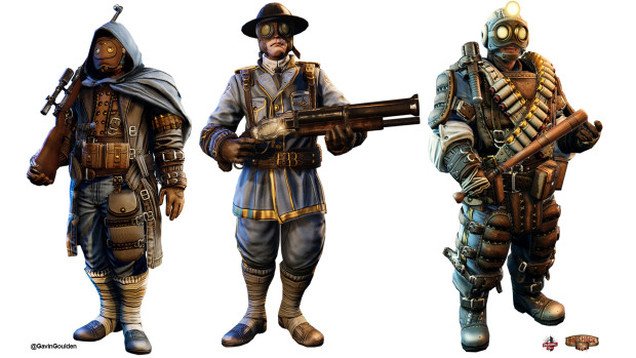
Comments
3 responses to “How To Create A Game Character That Doesn’t Suck”
Jennifer Hale is one of the best actors ever.
I thought this was going to be a discussion about character creation. You know. Attributes, feats, abilities,skills etc and their impact on games and when skills become game breakers etc. Guess what kind of games I normally play.. 😛
Along with “not releasing the same game every year with a different skin” and “not pissing off the feminists”.